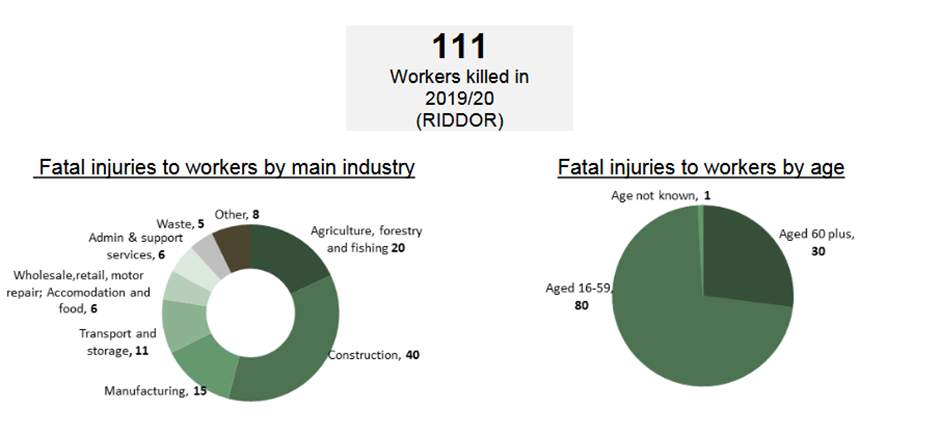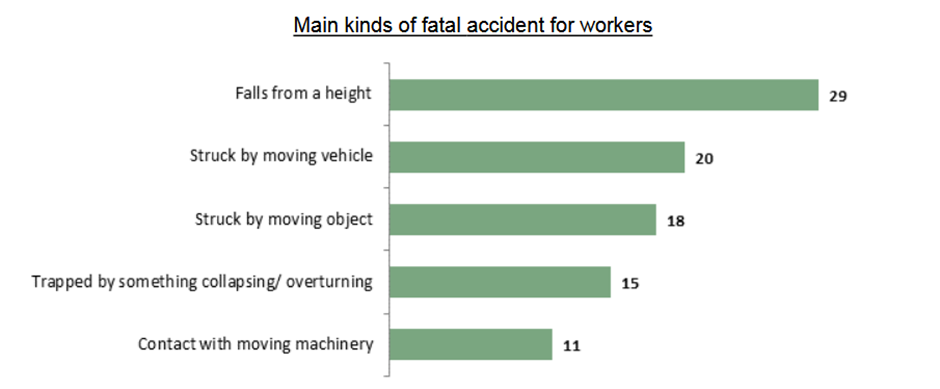Provisional figures from the HSE indicate that fatal injuries to individuals whilst at work in Great Britain reduced by 38 this year to 111, the lowest annual level on record.
Clearly that is good news however statistically speaking it is likely that Covid-19 will have had an impact here, certainly throughout March and possibly February, as such it remains to be seen as to whether there has been a major shift in the ‘inherent dangerousness of workplaces’. Notably as a result of Covid-19 these figures also don’t include those fatalities that may have occurred in workplaces controlled by local authorities, which will be provided for later this month.
Construction Stands Out Again?
Construction was one of the few sectors that saw an increase in the number of fatalities up from thirty one (31) in 2018/19 to forty (40) in 2019/20 which lifted it above the five year average of thirty seven (37). Although importantly it should also be noted that a comparison of the ‘rate of fatal injuries’ by selected main industry groups (per 100,000 workers) places construction well behind: Agriculture, Forestry and Fishing, and Waste and Recycling.

These figures do not include deaths resulting from: natural causes, road traffic accidents, any form of commuting or service with the armed forces whilst on duty. Neither do they include (importantly!) those fatalities that result from occupational diseases.
In addition, it was reported that ninety two (92) members of the public also lost their lives as a result of work-related activity.
Fatal Accident Type
The most common type of fatal accident continues to be the result of: falls from height (29) and being struck by a moving vehicle (20) or by a moving object (18) which accounted for approximately 60% of deaths in 2019/20.

Age and Gender Continues to Have an Impact
As in previous reporting periods the vast majority of fatalities 108 (97%) were reported to be male workers.
Significantly 27% of fatalities were recorded from individuals above the age of 60 even though they constitute only 10% of the overall workforce and individuals above the age of 65 were found to be 4 x more likely to suffer fatality in the workplace than an individual under the age of 60.

Long Term Trend
Whilst there has been a considerable reduction in the fatalities that occur annually as a result of work place activity (there were 495 such fatalities reported in 1981), the last ten years have seen minimal improvement, with the average number of workers killed annually over the last five years being 137.
Occupational Diseases
It is difficult to ascertain these figures directly as they typically occur many years after exposure and although we are now better able to record deaths related to specific diseases such as asbestos related cancer (mesothelioma) of which 2,446 such deaths were recorded in 2018, other deaths relating to occupational disease still require estimation.
This year’s report estimates that in the region of 13,000 deaths occur each year as a result of occupational lung disease and cancer due to past exposure, primarily to chemicals and dust within the workplace.
Additional Key Facts

Conclusions
Whilst it may sound harsh – little appears to have changed over the last five years with the downward trend in workplace accidents plateauing. This year’s reduction in fatalities is clearly a welcome positive but it remains to be seen if it remains at this level once local authority figures are added and the full impact of Covid-19 assessed.
Once again there are clear statistical indications that fatalities in the workplace are heavily impacted by: industrial sector, gender, age and activity. The later being of particular concern as the state pension age is pushed back for individuals resulting in them inevitably being required to work until they are older.
The number of deaths resulting annually from past exposure to health-related hazards in the workplace are considerably greater than the headline figures surrounding fatal accidents but sadly these are often overlooked as individuals understandably look to the ‘here and now’ as the future seems a long way off.
The figures continue to suggest that employers must do more to challenge themselves and their line managers in a number of areas, not least:
- Do your H&S procedures adequately address those activities highlighted in the report as high risk (i.e. working at height, traffic management, etc)?
- How does your H&S policy provide for older workers? How do you determine their ability, fitness and competence to undertake tasks or operate in certain areas?
- Have you fully considered the impact of: dust, fume and the variety of chemicals in use within your work place?
- Are you undertaking the necessary monitoring to identify the true extent of the hazards your employees face in the workplace?
- Are you providing enough health monitoring on behalf of your employees to ascertain the impact of exposure?
- Are your H&S audits suitable and sufficient? Do you ensure that appropriate PPE is not only provided but in use and that activities are being undertaken in accordance with procedures?
- Are you ensuring that your sub-contractors (where appropriate) are meeting their statutory duties?
Huge improvements have been made with regard to workplace health and safety over a number of decades but the fact that those improvements appear to have plateaued is cause for concern.
Employers of all sizes (in all sectors) must of course continue to ensure that they not only have a suitable and sufficient safety program in place but they must also ensure that they are also providing the necessary training to individuals within their workforce, at the right time and irrespective of age or gender.
*Review the full report produced by the Health and Safety Executive.

